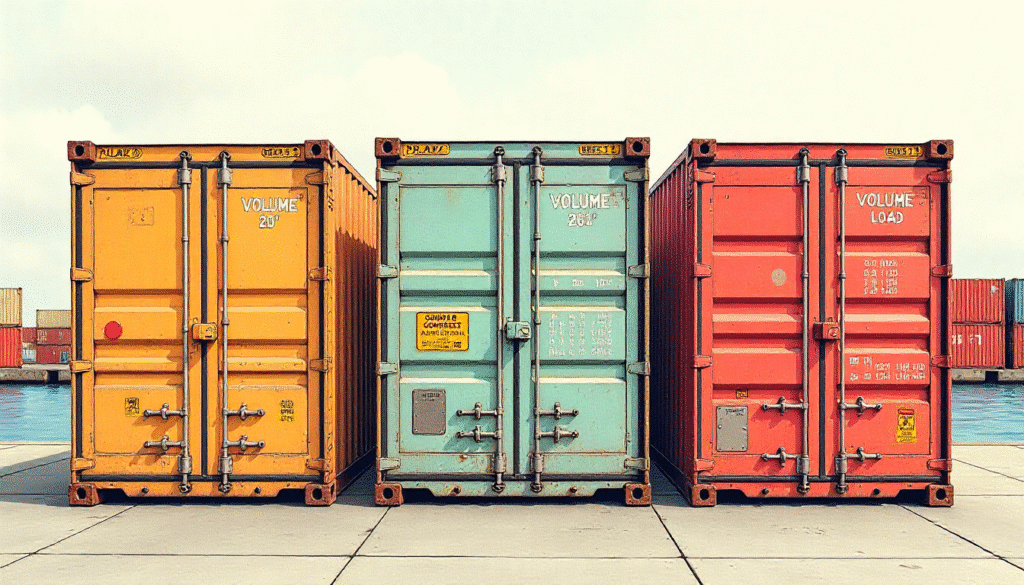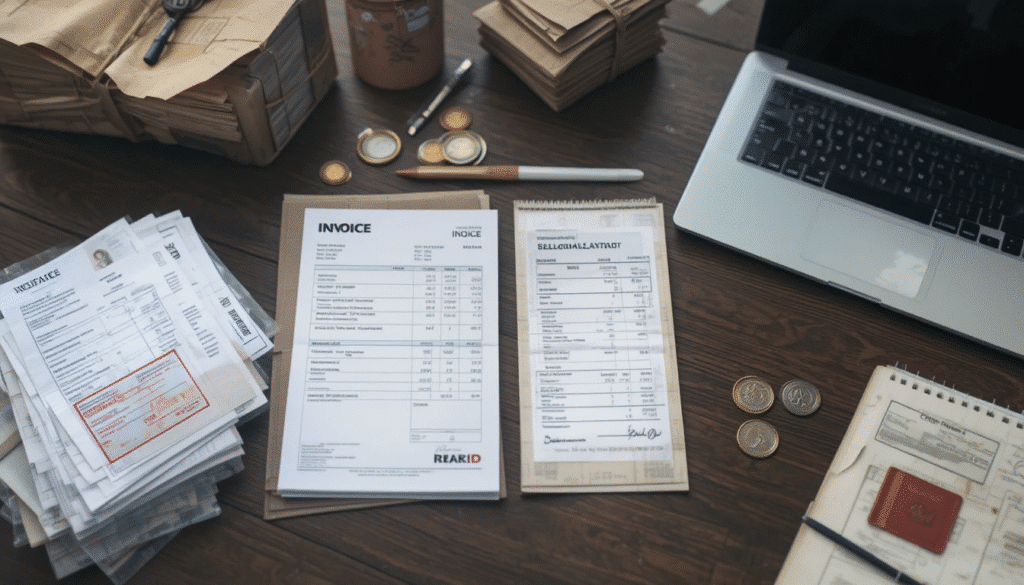The export corridor from China to Canada is one of the most dynamic and valuable trade lanes in North America. As a carrier, Chinese freight forwarder, or cross-border trade enterprise, selecting the right freight transportation services is critical to ensuring your cargo arrives on time, safely, and within budget.
This comprehensive 2025 guide will detail all primary transport options, cost factors, customs procedures, and technological innovations for shipping from mainland China to Canada, empowering you to make informed logistical decisions.
China remains the world’s manufacturing powerhouse, and Canadian demand for Chinese goods, from electronics and furniture to textiles and machinery, continues to expand. Whether you are shipping electronics, furniture, textiles, industrial equipment, or other commodities, this guide provides practical, actionable advice and data-driven insights.

1. Transport Modes and Routes
Transporte marítimo
Ocean freight is the most cost-effective transport mode for the China-Canada lane, ideal for large-volume, non-time-sensitive shipments.
Container Types and Capacity
International shipping relies on standardized containers. The most common types include:

Container Types and Capacity
FCL (Full Container Load): A single container dedicated to one shipper’s cargo, sealed at origin and opened at destination.
When to choose FCL: FCL is the most economical and secure option when your cargo volume exceeds ~15 CBM or when you need a dedicated container. It’s suited for high-volume importers, manufacturers, and retail chains.
LCL (Less Than Container Load): Handled by a sea freight forwarder, this is when cargo from multiple shippers is consolidated into a single shared container and billed by volume (CBM) or weight.
When to choose LCL: Choose LCL for volumes under 15 CBM, for shipments from multiple suppliers, or for distribution to different locations. It’s frequently used by SMEs, e-commerce sellers, and businesses testing the market.
Main Shipping Routes and Ports
Key Chinese Export Ports:
Shanghai (SHA): The world’s busiest port (50M+ TEUs/year), a key hub for China to canada shipping with stable, frequent sailings to North America.
Ningbo-Zhoushan (NGB): China’s second-largest port, showing strong growth and efficient services to Canada.
Shenzhen (SZX): The primary hub for Southern China’s manufacturing base.
Guangzhou (CAN): Strong connections to China’s inland provinces, ideal for large-scale cargo.
Qingdao (TAO): The main port for Northern China, serving exporters in the region.
Key Canadian Import Ports:
Vancouver (VAN): Canada’s largest and busiest port, serving as the primary gateway for over 50% of containerized cargo arriving from Asia.
Prince Rupert (PRR): The closest North American port to Asia (saving 2-3 days sailing time), designed specifically for rapid rail-sea intermodal transfer to inland markets.
Montreal (MTL): The second-largest port in Canada located on the St. Lawrence River, acting as a strategic hub for goods destined for Eastern Canada and the U.S. Midwest.
Halifax (HAL): An ice-free deep-water port on the Atlantic coast, capable of handling ultra-large vessels and serving as a key entry point for the Maritimes.
Toronto (TOR): While technically an inland port, it is a critical rail hub (RAMP) where a vast amount of cargo from Vancouver and Prince Rupert is cleared and distributed.
Transit Times
Typical ocean freight transit times from China to Canada:
Overall, in 2025, the total ocean journey from China to Canada typically takes 20 to 40 days, depending on the specific route, port efficiency, seasonal congestion, and customs clearance speed.

Transporte aéreo
Air freight is the premium solution for time-sensitive cargo, high-value goods, perishables, and urgent deliveries.
Standard Air Freight vs. Express Air Freight
Standard Air Freight:
- Transit Time: 5–8 days
- Cost: $5.50–$12.50/kg
- Billing: Charged by actual weight or volumetric weight (whichever is greater).
- Best for: Commercial cargo over 100 kg, often managed by a cargo agent for manufacturing parts, seasonal goods.
Express Air Freight:
Transit Time: 2–5 days
Cost: $10.00–$18.00/kg
Providers: DHL, UPS, FedEx, TNT, etc.
Best for: Urgent samples, small parcels, high-value items, door-to-door service.
Main Airports and Flight Times
Key Chinese Export Airports:
Beijing (PEK): Hub for Northern China, numerous direct North American flights.
Shanghai (PVG): World’s 3rd largest cargo airport (6M+ tons/year).
Shenzhen (SZX): Southern hub, strong advantage in electronics.
Guangzhou (CAN): Second-largest hub in Southern China.
Hangzhou (HGH): Emerging hub serving the Yangtze River Delta.
Key Canadian Import Airports:
Toronto (YYZ): Canada’s largest and busiest cargo hub, handling over 40% of the nation’s total air freight.
Vancouver (YVR): The primary trans-Pacific gateway, offering the shortest flight times from China and specializing in perishables and high-value electronics.
Montreal (YUL): A critical logistics node for Eastern Canada and Quebec, serving the region’s aerospace and pharmaceutical industries.
Calgary (YYC): A strategic hub for Western Canada with extensive cold-chain infrastructure, serving the prairie provinces.
Edmonton (YEG): A key entry point for Northern Canada and the energy sector, offering 24/7 cargo operations.
Air Freight Cost Calculation
Air freight billing uses “Chargeable Weight.”
Volumetric Weight (kg) = L(cm) × W(cm) × H(cm) / 6,000
Chargeable Weight = The GREATER of Volumetric Weight vs. Actual Weight.
Example: A shipment is 100x60x40 cm and weighs 50 kg. Volumetric Weight = 100x60x40 / 6,000 = 40 kg. Because the Actual Weight (50 kg) is greater, the shipment is billed at 50 kg. If the rate is $8/kg, the cost is 50 * $8 = $400.
Standard Air Freight Rates (2025 Reference, 100 kg):
Road/Trucking
Trucking is typically a supplementary service used in these scenarios:
Inland Transit: Moving containers from a port to an inland city (e.g., Vancouver to Toronto).
Last-Mile Delivery: Final delivery from the Canadian port/airport to the receiver’s address.
Cross-Border Trucking: Limited direct options for border cities (Toronto, Vancouver).
LTL (Less Than Truckload): For small-batch cargo, billed by weight or space.
FTL (Full Truck Load): Dedicating an entire truck, more cost-effective for large shipments.
Typical Trucking Times:
Vancouver Port to Toronto: 3–5 days
Vancouver Port to Montreal: 4–6 days
Montreal Port to Toronto: 1–2 days

Door-to-Door Service
Door-to-Door (D2D) is an all-in-one logistics solution. A specialized freight forwarder China to canada will manage the entire journey from the factory in China to the receiver’s address in Canada.
Service Scope and Process
A complete D2D service includes:
Pickup (China): From the factory, warehouse, or any location in China.
Domestic Transport (China): To the export port or airport.
Export Clearance: Handling export licenses, commercial invoices, B/L, etc.
International Freight: Ocean or air transport to Canada.
Import Clearance (Canada): Handling customs declarations and duty payment.
Domestic Delivery (Canada): Transport from the port/airport to the final address.
Common Incoterms Compared
(Note: DDU is an outdated term, officially replaced by DAP – Delivered at Place)
2. Fees and Cost Factors
Ocean Freight Cost Factors
Base Freight Charge: Set by freight transport companies (carriers) and determined by route, season, and market demand.
Port Charges:
Origin (China): Loading, handling, documentation ($50–$150/container).
Destination (Canada): Unloading, terminal handling ($50–$200/container).
Fuel Surcharge (BAF): 3–8% of base freight, fluctuates with oil prices.
Booking Space Fee: $100–$300 during peak season to reserve a slot.
Customs & Documentation: B/L, Commercial Invoice ($30–$80); Brokerage ($50–$150).
- Demurrage & Storage: 3 free days is common, then $5–$15/CBM per day.
Air Freight Cost Factors
Base Rate: Fluctuates ($4–$12/kg).
Fuel Surcharge (YQ/YR): 10–20% of the base rate.
Security & Handling: $50–$150.
Customs Fees: Same as ocean.
Overall Cost Comparison
2025 Cost Comparison: 500 kg Shipment Example:

3. Customs & Documentation
China Export Customs
Required Documents:
- Export License: Most goods are free, but restricted items (machinery, software) or dangerous goods require one.
- Commercial Invoice: Must list seller, buyer, description, quantity, price. English or Chinese.
- Bill of Lading (B/L) or Airway Bill (AWB): The contract of carriage and title of goods (for B/L).
- Packing List: Details contents, dimensions, weight, and packaging type for customs verification.
- HS Code (Harmonized System): China uses a 10-digit code (first 6 are international). Accuracy is crucial for Canadian tariffs.
- Certificate of Origin (CO): Certifies goods are “Made in China.”
- Special Permits: E.g., SDS (Safety Data Sheet) for dangerous goods, battery documentation.
Export Process:
- Declaration: Broker prepares and submits documents.
- Customs Review: Electronic submission to customs.
- Inspection: Random or targeted physical inspection by customs.
- Release: Customs approves the cargo for loading.
- Notification: Broker informs the forwarder of release.

Canada Import Customs
Required Documents:
- Commercial Invoice (copy): Required by CBSA (Canada Border Services Agency).
- B/L or AWB (copy).
- Packing List (copy).
- Canada Customs Coding Form (B3): Completed by a Licensed Customs Broker in Canada, who often works in partnership with your freight forwarder china to canada.
- Certificate of Origin (if applicable).
- Special Documents: E.g., Phytosanitary certificates (plants), compliance reports (machinery).
Import Clearance Process:
- Arrival: Cargo arrives at the Canadian port/airport.
- Manifest Report: Carrier submits the manifest to CBSA.
- Initial Check: CBSA verifies document completeness.
- Risk Assessment: System assesses risk.
- Release or Inspection: Low-risk is auto-released (often pre-arrival); high-risk/random is flagged for manual inspection.
- Duty Payment: Importer pays duties or provides a bond.
- Final Release: CBSA releases goods for pickup.
Canadian Duty Calculation
- Duty Base (Value for Duty) = CIF Value (Cost + Insurance + Freight)
- Duty = CIF Value × Applicable Tariff Rate
- GST = (CIF Value + Duty) × 5% (Goods and Services Tax, as of 2025)
Example:
Cost of Goods: $10,000
Freight: $1,500
Insurance: $200
CIF Value = $11,700
Duty (e.g., electronics, 0%): $0
GST = ($11,700 + $0) × 5% = $585
Total Import Cost = $11,700 + $0 + $585 = $12,285
4. Packaging & Cargo Handling
Standard Packaging Requirements
- General Cargo: 5-ply corrugated cartons or wooden crates. Fragile markings. Dunnage (bubble wrap, air cushions).
- Fragile Goods: 10cm buffer, wooden frames, palletizing. “All-Risk” insurance recommended.
- Electronics: Anti-static packaging, humidity indicators, multi-layer cushioning.
- Dangerous Goods (DG): UN-certified DG packaging, proper labels, and SDS must accompany the shipment.
Labels & Marks
Exterior labels must include:
- Consignee name, address, contact
- Consignor name, address
- Piece count (e.g., “1 of 10”)
- Handling marks (“Fragile,” “This Way Up”)
- Gross/Net Weight, Volume
- Tracking number
Interior Packing List should include:
- Product name, model
- Quantity, unit
- HS Code
- Unit price, total price
- Country of Origin
Weight & Volume Calculation
- Total Weight = Gross Weight (including packaging)
- Total Volume (CBM) = L(cm) × W(cm) × H(cm) / 1,000,000
- For ocean freight, carriers bill by weight or volume (whichever is higher, known as “Weight or Measure”).
- For air freight, use “Chargeable Weight” (Actual vs. Volumetric).

5. Risk Management & Insurance
Common Risk Factors
- Weather & Natural Disasters: Storms, typhoons, ice can cause delays or damage.
- Port & Transit Delays: Congestion, equipment shortages, or vessel schedule changes.
- Policy Changes: Sudden tariff adjustments or new import restrictions.
- Damage & Loss: Improper handling, stacking, or (rarely) container loss.
Insurance Types & Coverage
- All-Risk (Clause A): Covers all risks except specific exclusions (e.g., improper packing, normal wear, government intervention). Rate: 0.5–1.5% of cargo value. Highly recommended for high-value goods.
- Named Perils (Clause B/C): Only covers specific risks listed (e.g., fire, sinking, collision). Cheaper (0.2–0.8%), but less coverage.
- Water Damage: Specific coverage for water/moisture damage.
- War Risk: Covers war, terrorism, or political unrest.
Claims Process
- Report Loss: Notify carrier and insurer immediately upon discovering damage.
- Submit Proof: Collect photos, inspection reports, Commercial Invoice, and B/L.
- File Claim: Submit all documents to the insurer.
- Assessment: Insurer evaluates the claim.
- Payout: Approved claims are paid.
6. Technology & Sustainability
Logistics Tracking & Visibility
- GPS: Real-time tracking of trucks and containers.
- RFID: Tracks cargo movement within warehouses/ports.
- IoT Sensors: Monitor temperature, humidity, and shock for sensitive goods.
- Blockchain: Creates an unchangeable record of the supply chain, reducing documentation risk.
Sustainability & Green Measures
- IMO Regulations (2025 Update): The 2023 IMO regulations (EEXI, CII) are fully in effect in 2025, pushing for lower carbon intensity.
- Low-Carbon Options: Any worldwide shipping company must comply, driving costs slightly higher for older ships but promoting greener fuel.
- Carbon Footprint: Ocean freight (12-15 g CO₂/ton-km) is ~1/50th of air freight (600-900 g CO₂/ton-km).
- Warehouse Efficiency: Automation, LED lighting, and smart climate control reduce energy use.
Claims Process
- Report Loss: Notify carrier and insurer immediately upon discovering damage.
- Submit Proof: Collect photos, inspection reports, Commercial Invoice, and B/L.
- File Claim: Submit all documents to the insurer.
- Assessment: Insurer evaluates the claim.
- Payout: Approved claims are paid.

7. Logistics Provider Selection Guide
Evaluation Criteria
- Experience & Reputation: 3+ years on the China-Canada lane. ISO 9001, FIATA member? Check reviews.
- Network & Capability: Do they have offices or strong partners in both countries? Can they offer multiple freight transportation services (sea, air, intermodal)?
- Technology Platform: Do they offer a real-time tracking portal? Online quoting and invoicing?
- Customer Support: 24/7, bilingual (English/Mandarin) support? What is their average response time?
- Cost Competitiveness: Get 3+ quotes. Compare the total landed cost, not just the freight rate. Beware of hidden fees.
Conclusion
Shipping from China to Canada offers many options, each with trade-offs. Sea freight provides economy, air freight provides speed, and D2D provides convenience.
Summary of Scenarios:
How to Choose a Logistics Provider
- List Your Needs: Define your volume, frequency, and service requirements.
- Get Quotes: Request quotes from at least 3 providers (e.g., a mix of freight transport companies and specialized forwarders).
- Compare Total Cost: Include freight, insurance, customs, and last-mile delivery.
- Verify Credentials: Check licenses, industry certifications, and customer reviews.
- Sign a Contract: Clarify responsibilities, timelines, and claim procedures.
- Build a Relationship: A good long-term freight forwarder china to canada should get priority and may offer better terms.
Future Trends
- Automation & AI: Optimizing routes and container utilization to reduce costs by 5–10%.
- Green Logistics: IMO regulations are pushing costs up slightly but driving long-term sustainability.
- Blockchain Clearance: Electronic documents and smart contracts will speed up customs.
- Intermodal Transport: “Sea-Air” or “Rail-Sea” combinations will become more common to optimize the time/cost balance.
Contact Us for Professional Guidance
If you have questions about shipping from China to Canada, our professional logistics team is ready to provide customized solutions. We have years of China-Canada trade experience and a deep understanding of customs regulations.
Whether you’re a manufacturer, trader, or e-commerce platform, choosing the right logistics partner is the first step to success.
FAQ
It depends on 3 factors: Time (need it in <2 weeks? Use air), Value (high-value? Air reduces risk and capital-in-transit), Size (>15 CBM? Sea FCL is cheapest).
Express (DHL/UPS) (2-5 days) is fastest and simplest. Standard Air Freight (5-8 days) is cheaper but requires you to handle customs clearance separately.
Use LCL (a good Chinese Freight Forwarder can find you great LCL rates) if you don’t fill a container, optimize your packaging (reduce volume), book in advance (avoid peak season), and consolidate multiple orders into one shipment.
1-3 days for low-risk, automated release. 3-7 days for manual review. 7-14+ days for sensitive goods (food/medical) requiring inspection.
Yes. After a free period (usually 3 days), storage fees ($5–$15/CBM/day) and demurrage fees (container rental) apply. Clear your cargo quickly.
Ready to talk about your shipping needs?

